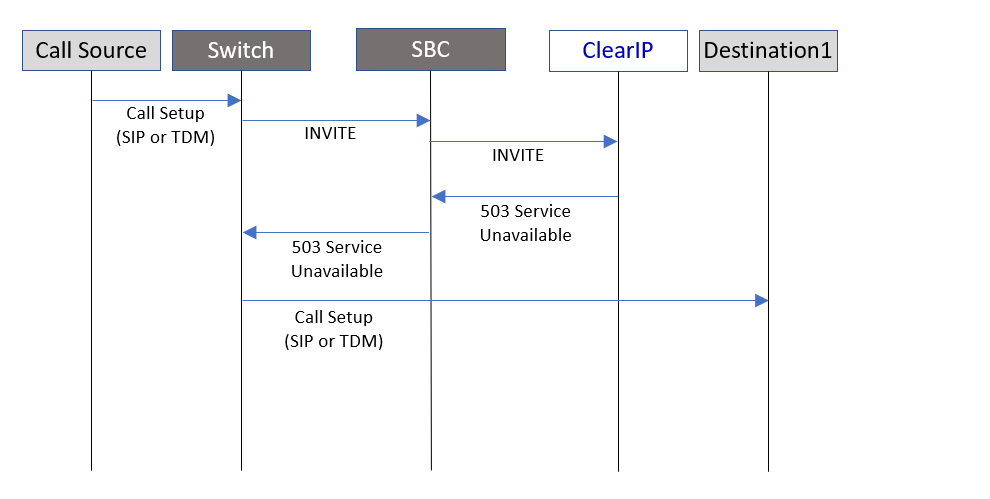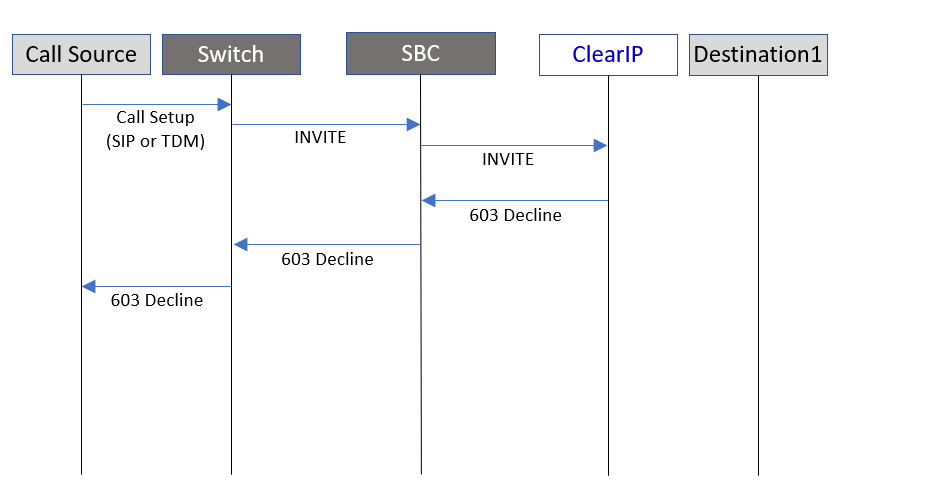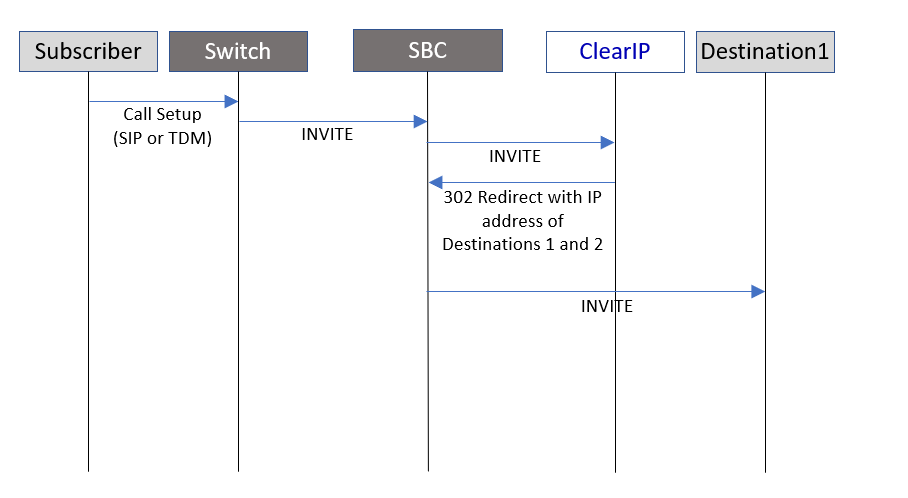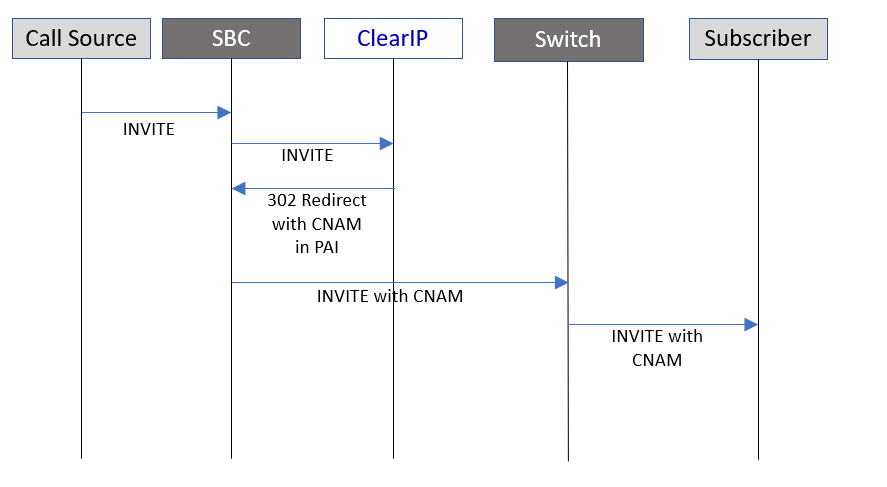The following diagrams illustrate the call flows and SIP integration between your network and ClearIP.
Route Advance on SIP 503 or SIP 404
The SIP Invite received by ClearIP is analyzed for robocall mitigation and/or toll fraud prevention. If no toll fraud is detected, the call is not blocked and ClearIP returns a SIP 503 Service Unavailable or SIP 404 Not Found to the switch.
The switch should be configured to route advance the call upon receiving a SIP 503 Service Unavailable or SIP 404 Not Found.
If you have an SBC, then calls from the switch would pass through the SBC to reach ClearIP. If no SBC is available, and the switch supports TCP and routing calls to domain names (e.g. sip.clearip.com), then the switch may route calls to ClearIP directly.

- Call Source sends a call to Switch over SIP or TDM.
- Switch sends SIP INVITE to SBC.
- SBC sends the SIP INVITE to ClearIP for robocall mitigation and toll fraud analysis.
- ClearIP responds to SBC with a SIP 503 Service Unavailable (or SIP 404 Not Found) message if no toll fraud is detected.
- SBC forwards the SIP 503 (or SIP 404) message to the Switch.
- Switch route advances to the next outbound trunk group in its routing table to complete the call to the destination.
If your routing policies are configured within your SBC, then your SBC should route advance the call upon receiving a SIP 503 Service Unavailable or SIP 404 Not Found. 
- Call Source sends a call to Switch over SIP or TDM.
- Switch sends SIP INVITE to SBC.
- SBC sends the SIP INVITE to ClearIP for robocall mitigation and toll fraud analysis.
- ClearIP responds to SBC with a SIP 503 Service Unavailable (or SIP 404 Not Found) message if no toll fraud is detected.
- SBC route advances to the next outbound trunk group in its routing table to complete the call to the destination.
Example SIP 503 Service Unavailable message from ClearIP:
SIP/2.0 503 Service Unavailable
Via: SIP/2.0/TCP outbound.sip.clearip.com:5060
To: <sip:18001234567@1.2.3.4:5060>;tag=b295b665-cf3e-48c9-b07c-65a36c49610f
From: <sip:14045266060@5.6.7.8:5060>;tag=123456789
Call-ID: 1-12345@5.6.7.8
CSeq: 1 INVITE
Reason: SIP;cause=503;text="no-fraud-detected"
Content-Length: 0
Example SIP 404 Not Found message from ClearIP:
SIP/2.0 404 Not Found
Via: SIP/2.0/TCP outbound.sip.clearip.com:5060
From: <sip:14045266060@5.6.7.8:5060>;tag=123456789
To: <sip:18001234567@1.2.3.4:5060>;tag=b295b665-cf3e-48c9-b07c-65a36c49610f
Call-ID: 1-12345@5.6.7.8
CSeq: 1 INVITE
Reason: SIP;cause=404;text="no-fraud-detected"
Content-Length: 0
Block on SIP 603 Decline
The SIP Invite received by ClearIP is analyzed for robocall mitigation, toll fraud prevention, STIR/SHAKEN authentication, and/or least cost routing. If toll fraud is detected and ClearIP is configured to block toll fraud, then ClearIP returns a SIP 603 Decline message. No STIR/SHAKEN authentication or least cost routing is performed.
The switch or SBC must be configured to block calls upon receiving a SIP 603 Decline to prevent route advance.

- Call Source sends a call to Switch over SIP or TDM.
- Switch sends the SIP INVITE to SBC.
- SBC sends SIP INVITE to ClearIP for toll fraud control.
- If ClearIP detects fraud, and is configured to block toll fraud calls, it will return a SIP 603 Decline message.
- SBC forwards the SIP 603 Decline message to the Switch.
- Switch proxies the SIP 603 Decline message back to the call source to block the call.
Example SIP 603 Decline message from ClearIP:
SIP/2.0 603 Decline
Via: SIP/2.0/TCP outbound.sip.clearip.com:5060
From: <sip:14045266060@5.6.7.8:5060>;tag=123456789
To: <sip:18001234567@1.2.3.4:5060>;tag=b295b665-cf3e-48c9-b07c-65a36c49610f
Call-ID: 1-12345@5.6.7.8
CSeq: 1 INVITE
Reason: SIP;cause=603;text="blacklisted"
Content-Length: 0
Routing on SIP 302 Moved Temporarily
The SIP Invite received by ClearIP is analyzed for robocall mitigation, toll fraud prevention, and/or least cost routing. If toll fraud is not detected, then ClearIP returns a SIP 302 Moved Temporarily message, containing configured routes listed in a Contact header.
The switch or SBC should be configured to redirect the call to the destinations returned in the Contact header based on a SIP 302 message.
This example shows the SBC consuming the SIP 302 and redirecting the call. If the routing should be performed by the switch, then the SBC can be configured to proxy the ClearIP SIP 302 response back to the switch, for the switch to redirect the call.

- Call Source sends a call to switch over SIP or TDM.
- Switch sends SIP INVITE to SBC.
- SBC sends the SIP INVITE to ClearIP for robocall mitigation, toll fraud prevention, and/or least cost routing.
- ClearIP responds to Proxy with a SIP 302 Redirect message with Contact header including the IP addresses of the Destinations.
- SBC sends a redirected SIP INVITE to the first Destination listed in SIP 302 Contact header.
- If the first Destination is unable to complete the call, then SBC attempts to route the call to the second Destination listed in SIP 302 Contact header and so on.
Example SIP 302 Moved Temporarily message from ClearIP that contains 4 routes listed in the Contact header:
SIP/2.0 302 Moved Temporarily
Via: SIP/2.0/TCP outbound.sip.clearip.com:5060
From: <sip:14045266060@5.6.7.8:5060>;tag=123456789
To: <sip:18001234567@1.2.3.4:5060>;tag=b295b665-cf3e-48c9-b07c-65a36c49610f
Contact: <sip:18001234567@1.1.1.1>;q=0.99, <sip:18001234567@2.2.2.2>;q=0.98, <sip:18001234567@3.3.3.3>;q=0.97, <sip:18001234567@4.4.4.4>;q=0.96
Call-ID: 1-12345@5.6.7.8
CSeq: 1 INVITE
Reason: SIP;cause=302;text="no-fraud-detected"
Content-Length: 0
STIR/SHAKEN Authentication
The SIP Invite received by ClearIP is analyzed for robocall mitigation, toll fraud prevention, STIR/SHAKEN authentication, and/or least cost routing. If toll fraud is not detected, then ClearIP returns a SIP 302 Moved Temporarily message, containing configured routes listed in a Contact header and an Identity header.
Your switch or SBC must be able to copy the SIP Identity header from a SIP 302 redirect message into a SIP INVITE message to the next hop destination.

- Call Source sends a call to switch over SIP or TDM.
- Switch sends SIP INVITE to SBC.
- SBC sends the SIP INVITE to ClearIP for STIR/SHAKEN authentication, routing, toll fraud prevention and/or robocall mitigation.
- ClearIP responds to SBC with a SIP 302 Redirect message with STIR/SHAKEN Identity header and Contact header including the IP addresses of the Destinations.
- SBC inserts the Identity header into the SIP INVITE and sends a redirected SIP INVITE with Identity header to the first Destination.
- If the first Destination is unable to complete the call, then SBC routes the call with Identity header to the second Destination listed in SIP 302 Contact header and so on.
Example SIP 302 Moved Temporarily message from ClearIP that contains routes in Contact header and STIR/SHAKEN Identity header:
SIP/2.0 302 Moved Temporarily
Via: SIP/2.0/TCP outbound.sip.clearip.com:5060
To: <sip:+16156565725@1.2.3.4:5060>;tag=b295b665-cf3e-48c9-b07c-65a36c49610f
From: <sip:+12065022424@5.6.7.8:5060>;tag=123456789
Call-ID: 1-12345@5.6.7.8
CSeq: 1 INVITE
Identity: eyJhbGciOiJFUzI1NiIsInBwdCI6InNoYWtlbiIsInR5cCI6InBhc3Nwb3J0IiwieDV1IjoiaHR0cHM6Ly9jZXJ0aWZpY2F0ZXMuY2xlYXJpcC5jb20vMGI5OGVjZjQtMGE0My00Yjg5LThmYzAtOGUwMjlkODI1OGZhL2I3OWFiOWExNDM0MjNiNDhiZGRkNmY5MWFhYjFjMTk2LmNydCJ9.eyJhdHRlc3QiOiJBIiwiZGVzdCI6eyJ0biI6WyIxNjE1NjU2NTcyNSJdfSwiaWF0IjoxNjI2MzY5NzE1LCJvcmlnIjp7InRuIjoiMTIwNjUwMjI0MjQifSwib3JpZ2lkIjoiMmUyMmRiYmQtOWJkZi00N2QwLThjOTgtM2E4MTcyY2JlMjZkIn0.Qoupqd9HIy5zazCs-DFeVIHeNOIVSjI9HUKiCfXkoom-I9gJqIqvh_ZxN5j00MLeMk2Xib8Ufj8_fGEQ_H7KGA;info=<https://certificates.clearip.com/0b98ecf4-0a43-4b89-8fc0-8e029d8258fa/b79ab9a143423b48bddd6f91aab1c196.crt>;alg=ES256;ppt=shaken
Contact: <sip:+16156565725@1.1.1.1>;q=0.99, <sip:+16156565725@2.2.2.2>;q=0.98
Reason: SIP;cause=302;text="no-fraud-detected"
Content-Length: 0
The switch or SBC must copy the Identity header from the SIP 302 message and send a redirected SIP INVITE with Identity header to Destination:
INVITE sip:+16156565725@1.1.1.1 SIP/2.0
Via: SIP/2.0/UDP 1.1.1.1:5060;branch=z9hG4bKEC001QwRn3bWxAmK00054B
Call-ID: 1-12345@5.6.7.8
CSeq: 1 INVITE
From: <sip:+12065022424@5.6.7.8>;tag=LgTdPYBHBRDUcv2S00054A
Max-Forwards: 70
To: <sip:+16156565725@1.1.1.1>
Identity: eyJhbGciOiJFUzI1NiIsInBwdCI6InNoYWtlbiIsInR5cCI6InBhc3Nwb3J0IiwieDV1IjoiaHR0cHM6Ly9jZXJ0aWZpY2F0ZXMuY2xlYXJpcC5jb20vdHJhbnNuZXh1cy9jM2E5ODQ5MGFjNzIxNmYzOGI5ZWE4ZmRmMjNmN2VkMy5jcnQifQ.eyJhdHRlc3QiOiJDIiwiZGVzdCI6eyJ0biI6WyIxODAzODM3MTc1MyJdfSwiaWF0IjoxNjIxOTY2NjIxLCJvcmlnIjp7InRuIjoiMTgwMzkzNzMzMzgifSwib3JpZ2lkIjoiMDVjNjkwYWQtNTM3OC00MjdmLWFjNzgtMTkxOGUxZWU3YjU5In0.CgumLyyBzKZ7T2UQxSC5bAexHY1qlWDD6xXGPH3ztVv5uECbFPYEs3T9QilPwsROB0jaCHxQYH-GVBeXNgAw5Q;info=<https://certificates.clearip.com/transnexus/c3a98490ac7216f38b9ea8fdf23f7ed3.crt>;alg=ES256;ppt=shaken
Content-Length: 0
You may need to configure ClearIP to return the Identity header using a special format depending on your switch or SBC platform. See the SBCs section for more information.
CNAM Integration
ClearIP can provide CNAM (Caller ID) for inbound calls to subscribers. The CNAM information is returned in the 302 response from ClearIP. The CNAM information is included in the display name of the P-Asserted-Identity header.
If the call is verified by STIR/SHAKEN, ClearIP can also add a “[V]” prefix to the CNAM data. If a robocall is detected, the CNAM can be replaced with “<SPAM>”.
Your switch or SBC must be able to copy the P-Asserted-Identity header from a SIP 302 redirect message into a SIP INVITE message to the next hop destination.

- Call Source sends a call to SBC.
- SBC sends the SIP INVITE to ClearIP for STIR/SHAKEN verification, robocall prevention, and/or CNAM lookup.
- If a robocall is not detected, then ClearIP responds to SBC with a SIP 302 Redirect message with CNAM in P-Asserted-Identity header.
- SBC inserts the P-Asserted-Identity header into the SIP INVITE and sends a redirected SIP INVITE with new P-Asserted-Identity header to the Switch.
Example SIP 302 Moved Temporarily message from ClearIP with CNAM returned in P-Asserted-Identity header:
SIP/2.0 302 Moved Temporarily
Via: SIP/2.0/TCP inbound.sip.clearip.com:5060
To: <sip:18172945075@inbound.sip.clearip.com;transport=tcp>;tag=68464514-5356-4d85-b54f-48db2b09809e
From: <sip:14045266060@5.6.7.8:5060>;tag=123456789
Call-ID: 281dcf03-ba5b-1239-33b9-12ab5f1d9310
CSeq: 29513529 INVITE
P-Asserted-Identity: "TransNexus" <sip:14045266060;verstat=TN-Validation-Passed@192.168.1.200>
Contact: <sip:18172945075@inbound.sip.clearip.com>;q=0.99
Reason: SIP;cause=302;text="no-fraud-detected"
Content-Length: 0
The SBC must copy the P-Asserted-Identity header from the SIP 302 message and send a redirected SIP INVITE with new P-Asserted-Identity header to switch:
INVITE sip:18172945075@1.1.1.1 SIP/2.0
Via: SIP/2.0/UDP 1.1.1.1:5060;branch=z9hG4bKEC001QwRn3bWxAmK00054B
Call-ID: 1-12345@5.6.7.8
CSeq: 1 INVITE
From: <sip:14045266060@5.6.7.8>;tag=LgTdPYBHBRDUcv2S00054A
Max-Forwards: 70
To: <sip:18172945075@1.1.1.1>
P-Asserted-Identity: "TransNexus" <sip:14045266060;verstat=TN-Validation-Passed@192.168.1.200>
Content-Length: 0
You may need to configure ClearIP to return the CNAM using a special format depending on your switch or SBC platform. See the SBCs section for more information.